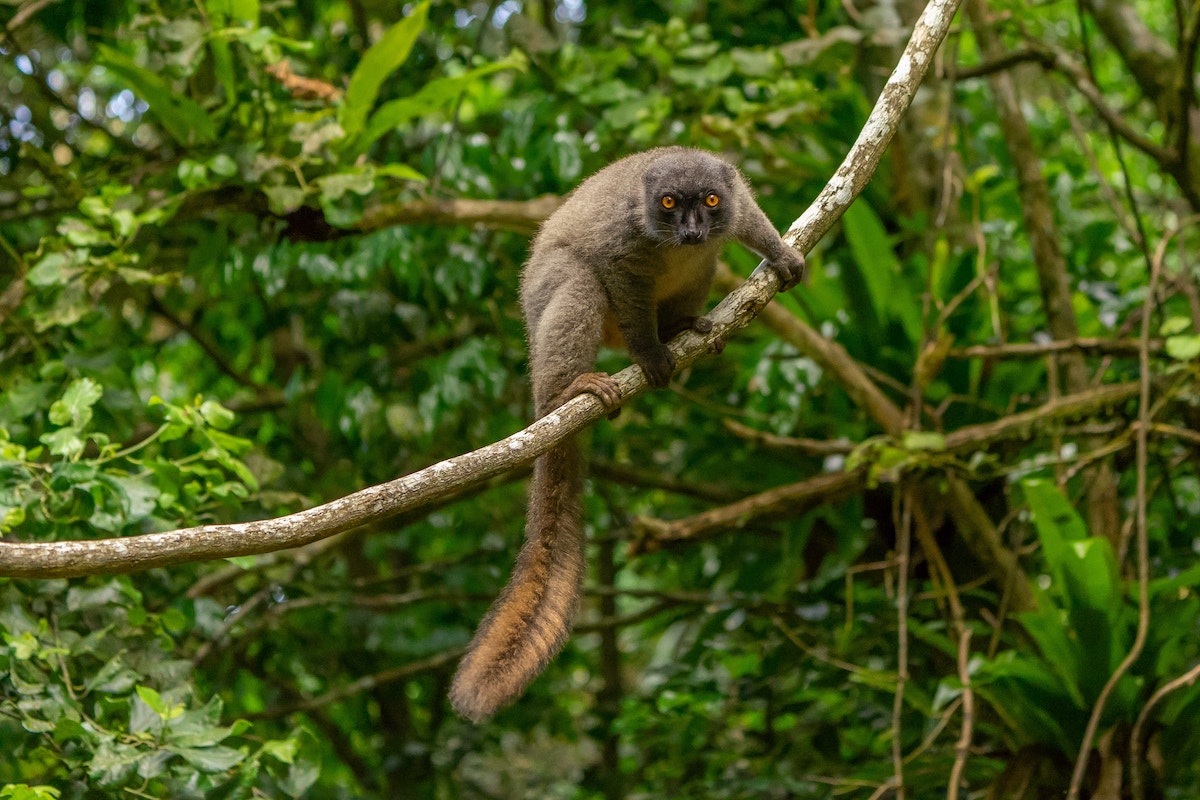
Andasibe-Mantadia National Park: A Haven for Endangered Species in Madagascar
By: Heather Keys / Sarah Stone
Skip to Section
Located in eastern Madagascar, Andasibe-Mantadia National Park is covered in dense rainforests, home to some of the island’s most amazing creatures. Established in 1989, this park is a fantastic destination for world wildlife and conservation.
Let’s have a look at what you can see here, including Madagascar’s lemurs, chameleons, and much more!
The Ecosystems of Andasibe-Mantadia National Park

Photo by Graphic Node on Unsplash
Covering an area of approximately 155 square kilometers, Andasibe-Mantadia National Park is a fantastic destination for nature enthusiasts and researchers alike. It’s located about three hours east of Madagascar’s capital city of Antananarivo by road, making it relatively easy to access.
The park is comprised of dense rainforests, with elevations ranging from 900 to 1,250 meters above sea level. It’s divided into two main sections: the smaller, more visited Andasibe (also known as the Perinet Reserve) and the larger, less frequented Mantadia.
Andasibe-Mantadia National Park has a rich ecosystem, home to over 110 species of birds, 50 types of reptiles, and more than 80 species of amphibians. One of the park’s most famous residents is the Indri, one of the world’s largest living lemur species, and which is endemic to Madagascar. The park is also recognized as an important habitat for many other threatened and endangered species, such as the Diademed Sifaka, the Parson’s Chameleon, and the Madagascar Tree Boa.
The plant life here is equally as diverse, with more than 1,000 different species of flora. The rainforest canopy is dominated by hardwood trees, such as ebony and Indian rosewood, which can grow up to 25 meters in height. And below, you’ll find ferns, mosses, and other shade-tolerant plants. The forest floor is a vibrant ecosystem as well, with fungi, lichens, and all kinds of insects that help with decomposition and nutrient cycling.
At this park, you’ll find over 100 different species of orchids, many of which can only be found in Madagascar. Some of the most striking orchids in the park are the snowy white Angraecum magdalenae and the almost extraterrestrial-looking Aeranthes ramosa. You can also find carnivorous plants, such as the pitcher plant (Nepenthes madagascariensis) and the sundew (Drosera madagascariensis).
The Lemurs of Andasibe-Mantadia National Park

Photo by Hans-Jurgen Mager on Unsplash
Andasibe-Mantadia National Park is home to several species of lemurs, including the Indri, diademed sifaka, and common brown lemur. These primates, each with their own unique characteristics, behaviors, and social structures, are the park’s star attractions.
- Indri: As one of the largest lemur species, these gentle giants are easily recognizable by their striking black and white fur, expressive eyes, and distinctive whooping calls.
- Diademed Sifaka: These lemurs are adorned with a distinct fur crown around their faces. Their black-and-white coloration—with a little orange-yellow mixed in—and nimble acrobatics make them a fun sight in the park.
- Common Brown Lemur: Smaller than their counterparts, the common brown lemurs sport a reddish-brown coat, bright orange eyes, and a long tail.
Lemurs play a vital role in the park’s ecosystem, contributing to seed dispersal and pollination and serving as a food source for predators. As for their diet, lemurs subsist on fruits, leaves, and insets.
As social creatures, they live in groups of varying sizes, with some species exhibiting matriarchal or patriarchal structures. Lemurs communicate through various vocalizations, including calls and songs, which help maintain social bonds and warn of potential threats.
The Chameleons and Other Reptiles of Andasibe-Mantadia National Park

Photo by Pierre Bamin on Unsplash
You can find many different reptile species throughout Andasibe-Mantadia National Park—alongside the park’s famous lemurs, these scaly friends contribute to the park’s biodiversity. Two highlights:
- Panther Chameleon: The panther chameleon is recognizable by its psychedelic coloration and long tongue, used to snatch unsuspecting prey. Males display a dazzling array of colors, while females exhibit more subdued hues.
- Leaf-tailed Gecko: The leaf-tailed gecko is best known for its amazing ability to blend seamlessly with its surroundings. Its namesake leaf-like tail and camouflaged skin make it a stealthy forest inhabitant.
Chameleons and other reptiles have a range of adaptations and features that enable them to thrive in their habitats—most notably, their color-changing skin, which allows them to blend in with the environment, signal emotions, and communicate with other chameleons. They also have bulging, specialized eyes that let them see in multiple directions simultaneously, providing them with exceptional awareness of their surroundings. And their prehensile tail lets them grasp onto branches securely, delivering increased agility and stability in their arboreal habitat.
These reptiles are crucial in maintaining the park’s ecosystem, serving as predators and prey. They help regulate insect populations and act as a food source for larger predators, contributing to the overall health and balance of the park’s biodiversity.
Frogs and Other Amphibians in Andasibe-Mantadia National Park
Andasibe-Mantadia National Park is home to many amphibians, including notable species such as the tomato frog and golden mantella:
- Tomato Frog: The tomato frog is a large, brightly colored species that uses its red hue as a warning signal to deter potential predators. Its striking appearance is a great example of aposematism in the animal kingdom.
- Golden Mantella: Though small, the golden mantella is no less impressive! Its brilliant coloration serves as a means of communication and territory defense among its kin.
Frogs and other amphibians do their part to keep the park’s ecosystem balanced by providing insect population control (which curbs the spread of diseases) and nutrient cycling as their tadpoles contribute to transferring nutrients within aquatic areas.
Environmental and Wildlife Conservation in the Park

Photo by Sandy Ravaloniaina on Unsplash
Environmental and wildlife conservation are at the core of Andasibe-Mantadia National Park’s mission. To achieve this, a variety of programs and initiatives are in place, involving:
- Local communities who contribute their knowledge and understanding of the area’s ecosystems
- Organizations, both local and international, that support conservation projects and funding
- Government agencies that implement policies and guidelines to protect the park’s biodiversity
Through this collaborative approach, the park’s wildlife populations are monitored, its ecosystems managed, and visitors educated about the importance of conservation practices. The park’s conservation efforts have led to several notable achievements:
- Protection of endangered species, such as the Indri, diademed sifaka, and golden mantella, through habitat preservation and monitoring
- Reforestation initiatives aiming to restore lost habitats and increase the park’s overall biodiversity
- Community-based conservation programs empowering local people to take an active role in protecting their environment and natural resources
The unique and wonderful animals of the park draw visitors from across the globe. Travelers to Andasibe-Mantadia National Park can see lemurs, chameleons, frogs, and so much more in their natural habitat through guided tours and night walks. And if you’ve had the chance to go to a rainforest—or if visiting one is on your must-see list—share your stories, questions, and advice with the Frayed Passport community!
More articles about rainforests:
- Everything You Need to Know About Amazon Rainforest Lodges
- Slapped by a Sea Turtle: Volunteering Abroad in Costa Rica
About the Author
Originally from Indiana, Heather believes every destination has a story worth telling and a reason to visit. With a deep love of adventure, history, and psychology, she shares travel trivia, tips, and inspiration to encourage you to explore the world with curiosity and optimism. Read her other articles on Frayed Passport here.Featured image by Diana Parkhouse on Unsplash
Information published on this website and across our networks can change over time. Stories and recommendations reflect the subjective opinions of our writers. You should consult multiple sources to ensure you have the most current, safe, and correct details for your own research and plans.
Frayed Passport is a participant in the Amazon Associates Program, an affiliate advertising program designed to provide a means for sites to earn advertising fees by advertising and linking to Amazon.com. We also may share links to other affiliates and sponsors in articles across our website.





